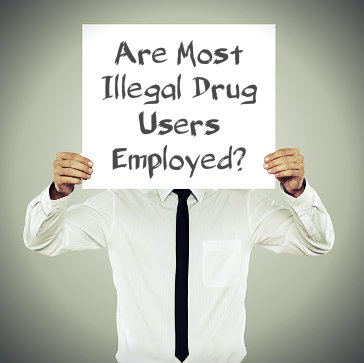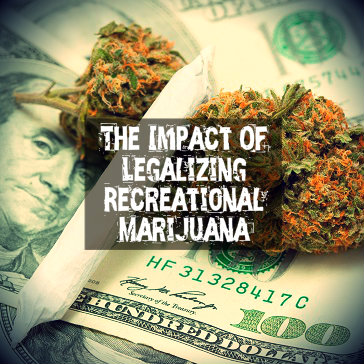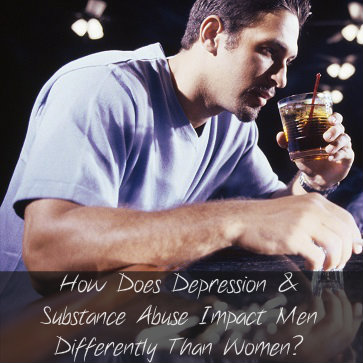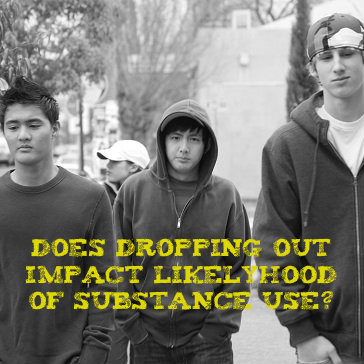23 Jan 2014
What Is Kratom And What Are Its Health Risks?
Kratom is the common name for an herbal drug obtained from a tree species called Mitragnya speciosa. This drug has a history of use in Southeast Asia and current evidence indicates that its use is currently on the rise in the U.S., where consumers can make legal purchases over the Internet. Kratom apparently has the potential to
Read More
21 Jan 2014
Are Most Illegal Drug Users Employed?
A US government study on drugs in the workplace has caused some business owners and community activists to raise questions about medical marijuana policies.
 Annie Short, the manager of a Wisconsin-based wellness program, recently gave a talk called “Drug Abuse and the Cost to Businesses” at a wellness council luncheon. She urged her community to rethink the state’s consideration of legalizing marijuana. Because over 70 percent of individuals using illegal drugs are employed, the manager’s discussion posed a thought-provoking question: Are employers willing to let those drug abusers perform public services, such as bus drivers, police officers and pilots?
Annie Short, the manager of a Wisconsin-based wellness program, recently gave a talk called “Drug Abuse and the Cost to Businesses” at a wellness council luncheon. She urged her community to rethink the state’s consideration of legalizing marijuana. Because over 70 percent of individuals using illegal drugs are employed, the manager’s discussion posed a thought-provoking question: Are employers willing to let those drug abusers perform public services, such as bus drivers, police officers and pilots?
Short shared some statistics from a U.S. Department of Labor, Small Business Administration and the National Institute on Drug Abuse survey.
Workplace Drug-Use Stats:
- Employees who are substance abusers cause 40 percent of accidents that happen on the job
- Due to lost time, health care cost, worker’s compensation and accidents, drug abusers cost employers an estimated $81 billion annually
- Drug users are more likely to ask for time off, have repeated absences and be late for work
- Drug users are five times more likely to make a worker’s compensation claim
Employees Using Drugs And Stealing At Work?
Statistics from a national cocaine helpline reported that 75 percent of callers admitted to using drugs while working. They also reported that drugs had a noticeably adverse effect on their ability to complete their jobs. Eighteen percent of callers reported stealing from co-workers and employers to support their drug habits.
Drug-Free Changes For The Workplace
Community leaders and advocates against the legalization of marijuana have a clear message: Employers and companies must make a drug-free workplace a top priority. Employers should implement policies that have clear and strict discipline, with termination for employees who are found to be using drugs while working.
In order to have a workplace that is drug-free, employers should implement employee education, a substance abuse support program, training and regular drug testing.
Read More On What You Should Know About Substance Abuse In The Workplace
When Colorado’s new law legalizing the use of marijuana went into effect there were mixed feelings about the consequences. Some opponents of the legalization argue that more children will become addicted to the drug at a younger age. They also caution that marijuana is a “gateway drug” to harder drugs like heroin and cocaine, and that it is known to cause health and psychological problems. What are Colorado’s laws that will aid in controlling marijuana consumption, keeping it in the hands of responsible individuals who are of age?
The Laws And Ways Of Obtaining Pot
Colorado actually has two sets of marijuana laws on the books. The laws for recreational use went into effect on January 1, 2014, but medicinal use has been legal since November 7, 2000. Not only are there different laws but there are also different locations for obtaining pot, with medicinal users getting it from dispensaries and recreational users going to newly opened shops.
 The main reason for the separate laws is the taxes levied against recreational users. Though medicinal users pay less taxes, they also have to get a Colorado Medical Marijuana Registry identification card, otherwise known as a “red card,” which costs $90 to obtain and to renew. (The price will be lowered to $15 in February 2014.)
The main reason for the separate laws is the taxes levied against recreational users. Though medicinal users pay less taxes, they also have to get a Colorado Medical Marijuana Registry identification card, otherwise known as a “red card,” which costs $90 to obtain and to renew. (The price will be lowered to $15 in February 2014.)
Colorado law bans the consumption of marijuana in public places, driving under the influence and taking the drug out of state. The state has also made it easier to win convictions against drivers who caused accident or injury while under the influence of drugs. The legal age of use is 21.
Recreational users can legally grow and possess up to six plants, up to one ounce of cultivated marijuana while traveling, and give a gift of up to one ounce to those 21 and up. Medicinal users can grow six plants as well, can possess up to two ounces of cultivated marijuana and can also gift up to an ounce to others who are at least 21.
Legal Marijuana Possibly Bringing In Big Bucks
Those who are celebrating the new law are optimistic about the revenue that the retail stores will generate. Research conducted by ArcView Market Research, a company that tracks data from the marijuana industry, reported that medical marijuana generated $1.4 billion in 2013. The researchers predict that number to grow to $2.34 billion in 2014, thanks to the new laws in Colorado and those in Washington, which will have its own law legalizing marijuana that will go into effect later this year. State officials predict that marijuana sales will generate an estimated $67 million in annual tax revenue.
Legal Marijuana’s Impact On Future Abuse And Addiction
Whether Colorado residents are for or against the legalization of marijuana, the impact of legalization on abuse and addiction could be seen for years to come.
Read More About The Pros And Cons Of Legalizing Recreational Marijuana And What It May Do For The Economy Of Our Country And The Health Problems Of Users
When it comes to clinical depression, it’s typical to think of it as a disorder that largely affects women. However, men suffer from depression too, and it has the same profound impact on their mood, energy levels, and quality of life. Just as with women, it’s common for men with depression to abuse substances – particularly marijuana, stimulants and alcohol abuse – as a means of coping and alleviating symptoms.
While women are more likely than men to suffer from clinical depression [1], as many as six million American men experience symptoms every year [2]. Symptoms of depression in men sometimes don’t mirror those found in women. Research indicates that males may not always struggle with overwhelming sadness or excessive guilt. Instead, their symptoms more commonly include fatigue, anger, irritability, and sleep disturbances [3].
The Depression And Substance Abuse Connection
Depression and substance abuse frequently occur together. For example, it’s estimated that 40% of all people with depression struggle with alcohol abuse [4] – that’s a staggering statistic. Depressed men may also smoke marijuana, which can elicit feelings of relaxation and numb overwhelming negative emotions, like irritability.
While alcohol and marijuana are commonly abused, some depressed men abuse stimulants, like cocaine, speed, or prescription medications used to treat ADHD and narcolepsy. These drugs can produce a pleasurable high that can offset symptoms. For instance, a depressed man may take a stimulant medication, like Adderall or Ritalin, in order to find the energy to go to work.
 In some cases, depression symptoms appear before a substance abuse problem. Feelings of helplessness or worthlessness lead some individuals to self-medicate with substances. Initially, doing so seems to numb or relieve symptoms. However, in reality, many substances negatively affect brain chemicals linked to mood regulation. Many men drink or use drugs to feel better, sadly end up feeling worse. Rather than stop, he continues to drink or use in order to get high.
In some cases, depression symptoms appear before a substance abuse problem. Feelings of helplessness or worthlessness lead some individuals to self-medicate with substances. Initially, doing so seems to numb or relieve symptoms. However, in reality, many substances negatively affect brain chemicals linked to mood regulation. Many men drink or use drugs to feel better, sadly end up feeling worse. Rather than stop, he continues to drink or use in order to get high.
This vicious cycle can also start with substance abuse. In particular, depressant substances, such as alcohol, lower levels of serotonin. Serotonin is one of the chemicals in the brain that helps keeps mood stable. Over time, the alcohol abuse may actually trigger or contribute to symptoms of depression. Chronic stimulant use is also linked to depression. An addicted male will suffer withdrawal, usually marked by a range of uncomfortable symptoms which include depression.
Why Men Don’t Seek Treatment For Depression As Often As Women
In the U.S., women are diagnosed with depression as anywhere from two to four times more frequently than men [5]. This gap may stem from several factors, including:
Traditional ideas about men – Traditionally, emotional expression hasn’t been highly valued among males. Expressing sadness, frustration, or helplessness can be – and often is – seen as a sign of weakness or lack of discipline. A man may hesitate or refuse to seek depression and substance abuse treatment because he worries it will damage his masculinity. Preconceived ideas about men and substance use can play a role as well. For instance, having a few beers after work every night may not only seem normal, but also expected, especially if a man’s father or grandfather did the same.
Lack of knowledge – It’s likely that some men don’t seek treatment for depression or substance abuse because they’re simply not aware they have a problem. It can be easy to write off negative feelings as a temporary setback or a normal reaction to severe stress or a major loss. A man may believe that if he just keeps pushing forward his emotions will eventually stabilize.
Substance abuse can be hard to recognize as well. This is particularly true if he’s abusing prescription drugs. He may take them with the belief (or rationale) that they’re much safer than street drugs or okay to use just because they’ve been prescribed by a physician. Likewise, a depressed substance abuser may not realize that seemingly harmless and more acceptable substances like marijuana and alcohol can alter the brain over time and lead to an addiction.
Lack of motivation – Experiencing a lack of motivation is one of the many symptoms of depression. A person can feel as though he has no energy, making it a challenge to get off the sofa – much less seek professional help.
Stigma – Sometimes men won’t seek treatment because they want to avoid the stigma of having a “mental illness”. There’s stigma linked to substance abuse as well. It’s hard to ask for help when a man believes others will be quick to label him as an addict. Drug abuse, in particular, carries a strong stigma that potentially affects relationships and work.
The Importance Of Mental Health Treatment
Psychiatric disorders, like depression and substance abuse, require treatment just like any medical condition such as heart disease, diabetes, or cancer. Mental health conditions are complex disorders that have a number of causes, some of them biological in nature. Although it can be difficult to reach out for depression and substance abuse treatment, professional help is crucial and can be highly beneficial.
Co-occurring conditions have a significant negative impact on your life. For example, your relationships are probably suffering. There may be frequent conflicts with those you love. You may be unable to be the father you want to be to your children. Additionally, depression and drug or alcohol abuse affect sexual performance, which can further strain your relationship with a significant other or spouse.
Work performance is likely suffering, too. Substance abuse combined with depression may make you more prone to calling in late or sick. Frequent absences can have serious consequences. It can also be harder to perform assigned tasks and complete important projects, leaving them undone or forcing colleagues to pick up the slack. When workplace performance suffers, you’re less likely to hold onto a job and may have trouble finding a new one.
Depression and drug or alcohol abuse also adversely impact your physical and emotional health. For example, depression has been linked to a higher risk of heart disease in men [6]. Research suggests that men with heart failure who had moderate to severe depression were nearly four times more likely to die than those who weren’t depressed [7]. In addition, depression and substance abuse are both connected to a higher risk of suicide. It’s estimated that, overall, men are four to five times more likely to complete suicide than women [5]. This is largely due to the fact that males are more likely to use more lethal methods, such as shooting themselves.
Depression And Substance Abuse Treatment
If you have symptoms of depression and abuse substances, you need treatment. Contact a mental health professional or drug treatment facility that offers “dual diagnosis” treatment. If you’re not sure where to start, ask your primary care physician for a referral. Once you’re working with a mental health professional, be open about all symptoms and fully disclose your substance abuse habits. He or she will diagnose you and develop a treatment plan that may include residential or outpatient therapy, support groups, and, if necessary, medication.
Don’t let life fall apart because of your symptoms. Help is available. Reach out now for depression and substance abuse treatment to reclaim your physical and emotional health.
Read More About Depression And Drug Treatment
References:
[1] http://www.nimh.nih.gov/statistics/1mdd_adult.shtml
[2] http://www.apa.org/research/action/men.aspx
[3] http://www.apa.org/research/action/men.aspx
[4] http://www.niaaa.nih.gov/news-events/news-releases/national-survey-sharpens-picture-major-depression-among-us-adults
[5] http://www.ncbi.nlm.nih.gov/pmc/articles/PMC3140791/#!po=4.16667
[6] http://circ.ahajournals.org/content/early/2013/10/30/CIRCULATIONAHA.113.002065.abstract.html?ijkey=xgzTuA4JxivZbxO&keytype=ref
[7] http://newsroom.heart.org/news/depression-in-heart-failure-patients-233191
Substance use is common in a substantial minority of high school-age children across the U.S. Significant numbers of high school-age children also discontinue their education, or drop out, before receiving a diploma and never complete an alternative GED program. In 2013, officials from the federal Substance Abuse and Mental Health Services Administration released a report that examined the connection between dropping out of high school and the risks for involvement in substance use. Information for this report came from nine years of data gathered from a project called the National Survey on Drug Use and Health.
Dropout Rates
The U.S. Department of Education tracks high school dropout rates in a couple of ways. One method involves counting the percentage of people between the ages of 16 and 24 who do not attend high school and don’t possess a high school diploma, a GED certificate or any other certificate from a recognized, alternative educational program. In 2011, the last year for which full figures are available, 7 percent of individuals in the target age range who were not institutionalized or incarcerated fit this definition. High school dropout rates can also be roughly calculated by seeing how many incoming freshman go on to receive a diploma within a standard four-year timeframe. Three out of every four students successfully graduate on time, while the remaining 25 percent do not. Apart from any substance-related issues, common consequences of dropping out of high school include making less money, not receiving health insurance coverage and having increased risks for poverty and serious health issues.
 Teen Substance Use Rates
Teen Substance Use Rates
The National Institute on Drug Abuse regularly tracks trends for substance intake in U.S. 8th graders, 10th graders and 12th graders. With the exception of involvement with inhalants, older teenagers consistently engage in substance use more often than younger teens. For example, in 2012 over 40 percent of 12th graders drank alcohol in an average month, while only 27.6 percent of 10th graders drank as frequently. Similarly, while almost 23 percent of all 12th graders used marijuana on a monthly basis, only 17 percent of 10th graders used the drug as frequently. Percentages of monthly alcohol and marijuana use were even lower in 8th graders. Marijuana ranks as the most common drug choice among all high school students.
How Dropping Out Influences Substance Use Rates
In the report published by the Substance Abuse and Mental Health Services Administration, researchers used data gathered from the National Survey on Drug Use and Health between 2002 and 2010 to identify high school-age children who had dropped out by the 12th grade and determine how dropping out influences substance use rates. The survey’s results indicate that 13.2 percent of teens old enough to be in the 12th grade failed to graduate in this nine-year timespan. The dropout rate among boys was 14.7 percent, while the rate among girls was 11.6 percent. The ethnic groups most likely to drop out before or during the 12th grade were Native Americans/Alaskan Natives and Hispanics. Asian Americans and whites had the lowest dropout rates.
When compared to 12th graders who stayed in high school, dropouts of the same age had consistently higher monthly rates for all forms of substance use. For example, while only 22.4 percent of all enrolled 12th graders smoked cigarettes, 56.8 percent of all dropouts the same age smoked. While 35.3 percent of enrolled 12th graders drank alcohol, 41.6 percent of all dropouts the same age drank. Twelfth grade-age dropouts also had a higher rate of participation in a form of dangerous, short-term alcohol consumption called binge drinking. In addition, while 18.2 percent of all enrolled 12th graders used marijuana or some other illegal or illicit drug, 31.4 percent of all dropouts the same age used an illicit/illegal drug.
When compared to their gender, peers who remained in school, both 12th grade-age dropout boys and 12th grade-age dropout girls had significantly higher rates of intake for all commonly used substances. White 12th grade-age dropouts also had higher rates of intake for all substances than white 12th graders enrolled in school. The same pattern held true for African-American 12th grade-age dropouts and African-American 12th graders still attending school. Hispanics also largely followed the same pattern; however, the alcohol use rate was slightly higher among 12th grade Hispanics still enrolled in school than among Hispanic dropouts the same age. The two groups also had almost equal rates for participation in prescription drug abuse.
Importance Of Substance Abuse Prevention
The findings published by the Substance Abuse and Mental Health Services Administration clearly indicate that people who drop out of high school have substantially higher chances of becoming involved in substance use than their peers who remain in school. In the future, public health officials can use this information to place special emphasis on substance abuse prevention efforts aimed at teenagers and young adults who did not graduate from high school.
Read More About Teen Substance Abuse
Who recognizes that they are enabling? Who enables so intentionally? And yet, if we have addicts in our lives, we must look carefully at how we interact with them. How do we handle a loved one with an addiction? The years of dealing with the addiction of a loved one blind us to our own actions and their consequences. Much of what we think is “helping” can actually be quite harmful.
Signs You Are Enabling
- Do you make excuses for the addict (e.g., lying to an employer to explain why the addict isn’t showing up for work)?
- Do you lie or deceive to protect the addict or your family’s image?
- Do you intentionally overlook bad behavior, saying that the addict “can’t help it?”
- Do you feel like you bear the brunt of consequences for the addict’s behavior?
- Do you continue to allow an addict son or daughter to live in your home despite substance abuse and his or her unwillingness to follow house rules?
- Do you loan or give money to the addict?
- Have you bailed the addict out of jail, or lied to protect him or her from getting in trouble with the law?
- Do you clean up the resulting mess? This can refer to the physical mess the addict makes during or after a binge as well as the messes he or she is making in life.
- Do you make his or her problems your responsibility?
- Are you trying to protect the addict from hitting bottom?
- Do you experience anxiety over the consequences the addict may experience as a result of his or her substance abuse?
- Do you excuse or overlook the addict’s words or actions when drunk or high?
- Do you feel guilty if you don’t help the addict?
- Do you do things for the addict that he or she can do for him or herself?
- Are you unable to say “no” to the addict?
- Do you live in fear of the addict?
- Are you constantly changing your plans to accommodate the addict’s antics, dramas and needs?
How Enabling Hurts Rather Than Helps The Addict
Enabling does not help or aid, rather it communicates the message that the addict’s actions have no consequences, or that if they do, someone (you) will be there to fix it, clean it up or excuse it away. If you are beginning to recognize enabling patterns in your relationship with the addict, know that it is not your fault. Life with a drug or alcohol addicted parent, spouse or child warps us. We are forced to find a means of coping with a situation that gradually grows more and more severe over time. In the beginning, a little helping isn’t an abnormal thing, but this helping subtly morphs, along with the addiction, into a full-blown condition.
What Can You Do Instead Of Enabling The Addict In Your Life?
What is the alternative? Letting go. And it will be painful to do. You may watch the addict lose jobs, get into trouble with the law, live in squalor, sink into poverty, and suffer all sorts of physical, mental and emotional discomforts. It will be as hard on you to watch as it will be for the addict to live through. You will want so badly to do something.
But when you do, you impede the addict from reaching that point at which he or she will become convinced of the need for a change, also known as “hitting bottom.” The longer you enable the addict and the addiction, the longer it will take the addict to pursue recovery. Get the support you need—either through Al-Anon, therapy or other support systems—and then call a halt to the cycle of enabling and addiction.
Learn How To Set Up A Safe Intervention For Your Addicted Loved One!
A new report shows a rise in U.K. hospital emergency room visits by adults in their forties for drug or alcohol issues. The country’s health providers are determined to continue tackling the issue of drug and alcohol abuse as they strive to lower the rate of substance abuse.
The report came from data firm Dr Foster Intelligence. The group used ER admissions records as the basis for who is most often abusing drugs and alcohol and how often that abuse reaches the level of required hospitalization. According to their 2013 Hospital Guide:
Hospitalizations For Drug And Alcohol Abuse
 19 percent of ER admissions of 40-44 year olds were directly related to alcohol or drug use. That figure was highest among all age groups.
19 percent of ER admissions of 40-44 year olds were directly related to alcohol or drug use. That figure was highest among all age groups.- 18 percent of 45-49 year old admissions were for the same alcohol or drug reasons.
- In 2002-2003 the average age for a binge-drinking related hospitalization was 16 years. By 2004-2005 the typical age was 19. In 2012-13 the average age of those entering the hospital for binge drinking was 32 years.
- Despite the rise in average age for binge drinking ER visits, adolescents and young adults remain the most apt to need hospital care for binging.
Based on the Dr Foster report, young people are revealing more wisdom than their parents. Part of the problem is that an alarming number of patients don’t seem to be finding their way to recovery:
- The typical age of a person needing hospitalization for drugs or alcohol reasons in 2002-2003 was 41 years. In 2012-2013 the typical age was 43.
- Dr Foster found that over 500,000 individuals needed hospitalization for their alcohol or drug abuse at least one time during the past three years.
- At least 120,000 of those admitted to the hospital were 40-something years old. That is double the number of folks in their 20s or 60s who needed hospital care for drugs or alcohol.
Repeat ER Visits For Drugs Or Alcohol
Looking at all hospital admittances for alcohol or drugs in 2012-2013 a surprising 36 percent had already been admitted more than one time for the same problem in the past. And five percent had been in the hospital for drug or alcohol issues five times or more.
The problem appears to be most acute among the poor in Britain, with 36 percent of ER visits coming from the poorest regions of the country, and only nine percent of them coming from wealthy sections of the population.
A Dr Foster spokesman said that their figures were likely on the low end of actual numbers. The group only used hospital admittances where alcohol or drugs were 100 percent responsible. Left out were the high number of other admissions where substances played a key role.
Turning The Substance Abuse Hospital Visit Problem Around
Healthcare workers and National Health Services spokespeople say that there are ways to turn the problem around. For example, in 22 percent of the hospitalizations no general practitioner was listed on the health form. This could indicate that people are attempting to hide their problem from their primary care doctor rather than use them as a resource. If primary care doctors would use the NHS Healthcheck guide as a screening tool for substance abuse, more cases might be able to be treated before they reached a critical stage.
Hospitals also intend to implement more direct interventions by health professionals. Placing nurses who function as alcohol liaisons in the ER is one way to accomplish that goal.
Read More About Increased ER Visits For Surprising Drugs
Self-reporting of drug use is an approach that uses interviews, questionnaires or surveys to determine whether a person uses drugs, has previously used drugs or currently has drugs in his or her system. This method differs from objective urine testing, a universally accepted approach that relies on chemical measurements to detect the presence of drugs. In a study published in October 2013 in the journal Addictive Behaviors, a team of researchers from several U.S. institutions compared the accuracy of self-reported drug use by teenagers and young adults in drug treatment to the accuracy of urine testing. The researchers found that individuals in these age groups tend to self-report their level of drug use with relatively consistent truthfulness.
Self-Reporting Drug Use
Drug treatment professionals and researchers use self-reporting to gather a range of statistics from small and large populations of drug users. Examples of the information commonly acquired include the absence or presence of drug use, frequency of drug use, larger patterns of drug use and the presence of underlying factors that may contribute to drug use frequency or drug use patterns in some way. Depending on the scope of an interview, survey or questionnaire, self-reporting may provide data on short-term drug usage, annual drug usage or lifetime drug usage. Some professionals and researchers use self-reporting to answer relatively simple questions about drug usage, while others use the technique in connection with complex formulas designed to gather very specific, detailed information from participants.
Urine Drug Testing
Urine drug testing is a specific form of urinalysis designed to detect the presence of commonly abused substances such as opioid narcotics, marijuana and other forms of cannabis, cocaine, amphetamine, methamphetamine and phencyclidine (PCP). In some cases, urine testing directly detects the presence of these substances; in other cases, it detects the breakdown products that these substances form after entering the bloodstream. A urine drug test only tells the person conducting the test whether an individual has used a particular substance within a narrow time span of roughly one to three days. It does not provide information about such factors as the method of drug use, the specific moment of drug use or the amount of drugs taken at a given time. Testers typically confirm the results of a urine drug test with a follow-up testing procedure designed to guarantee the final accuracy of the rendered results.
Accuracy Of Self-Reporting On Drug Use
Because urine drug testing provides an objective measurement of drug use, experts in the field commonly view this form of testing as the standard tool for detecting the presence of drugs in a person’s system. However, in certain situations, it is not necessarily convenient or practical to perform urine testing. In addition, the proper interpretation of testing results is sometimes relatively complex and time-consuming. For these reasons, doctors and other professionals sometimes have a real need for other ways of obtaining the information they require.
In the study published in Addictive Behaviors, researchers from three U.S. universities sought to determine if self-reporting of drug use can act as a reliable substitute for urine drug testing. They explored this question with the help of 152 teenagers and young adults enrolled in programs primarily geared toward the treatment of addictions to opioid narcotic drugs. Some of the participants received short-term (two-week) treatment with group/individual counseling and a standard combination of two opioid addiction medications called buprenorphine and naloxone. Others received longer-term (12-week) treatment with counseling and the combination of buprenorphine and naloxone. Self-reports and urine testing results were obtained from each group at regular intervals. Each participant received a small financial reward as an incentive to keep participating in the study.
After completing the study’s main phase, the researchers concluded that the teens and young adult participants provided self-reported information on drug use that generally matched up well with the objective measurements provided by urine drug testing. Generally speaking, these findings were unaffected by factors such as the amount of money received for participation and the specific nature of each individual’s drug addiction. However, the study’s authors also concluded that teens and young adults who received longer-term counseling and medication treatment had a greater tendency to under-report their drug use than teens and young adults who received shorter forms of treatment. Specifically, these individuals downplayed their involvement in both opioid and cocaine use.
So Is Self-Reporting Accurate Enough For Solo Drug Testing Use?
The authors of the study published in Addictive Behaviors believe that their findings demonstrate that teens and young adults in treatment commonly self-report their drug use accurately enough to give doctors a potential secondary alternative to urine drug testing. However, they also believe that the level of accuracy is not high enough to do away with the need for urine testing, especially in teens and young adults participating in relatively long-term treatment programs. And Save Your Life Or The Life Of A Loved One
Get Drug Rehab Counseling Help Now And Save Your Life Or The Life Of A Loved One!




